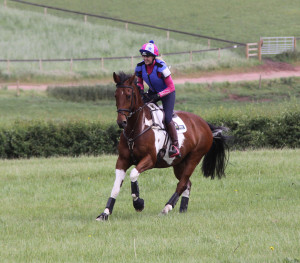In this issue event rider Bonnie Fishburn provides advice on riding a cross-country course.
Whilst fences are the obvious obstacle in cross-country riding, it is very much an all-round endurance test too and preparation is key.
Explains Bonnie:
Whilst you get the chance to see the fences in advance and plot your route, don’t forget your horse will be new to it all. To give you the greatest opportunity of going clear, think through the points mentioned below.
Try and walk the course on two different occasions, and if possible, watch a few riders tackling it. Don’t be afraid to jot down some notes as you walk and if possible, walk it on your own, or with your trainer, or with someone else you respect, so you can perfectly concentrate on it.
When you walk the course, be alert for anything that might spook your horse. Remember you could be riding it in different weather, so for example things that blow in the breeze could startle your horse. Hopefully you will have prepared for this eventuality already by having practised on fences where you have specifically set up spooky objects nearby.
The sun and time of day can make a course feel very different too. You need to consider where the sun will cast shadows at the time you are competing. In spring and autumn, low sun can also affect both your own and your horse’s vision.
You should also be aware of those things you know are likely to distract your horse and potentially take his attention away from the fence. In this case, you may decide to ride a fence slightly off centre, if the distraction is to one side.
When walking the course, look behind you as well as in front, to help you judge whether you have chosen the most economical route to a fence.
However, you should always have an alternative plan, in case something happens at the last minute that means you need to change your route.
It is useful to watch how top riders approach fences as this will help you improve your technique.
It’s also a really good idea to hire some local courses so you can practise jumping direct and alternative routes before an event.
There really is no substitute for practising good lines on your horse. You should set out a course on a flat area, and include a combination of poles in straight lines, circles and on bends.
If you concentrate on this, you will focus on riding the best line to each pole, rather than worrying about tackling the actual fences.
You should also incorporate hillwork into your training, to build muscle, stamina and strength. You should get your horse used to tackling fences on the brow of a hill; these are very different as your horse won’t see them until the last minute, so you need to ride a little steadier into the fence, giving your horse extra time to take in what he’s being asked to do.
A final tip from Bonnie concerns the weather. With heavy rain, the course is likely to ride deeper as the day goes on. Conversely, a hot, dry spell may make the ground hard and slippery.
Deep, wet ground is obviously more tiring for your horse so when you walk the course, you should look out for areas that will get more churned up, and see if you can take a different line to those fences to avoid the difficult ground.
On dry, slippery ground you will need to ride cautiously, especially on downhill sections.



